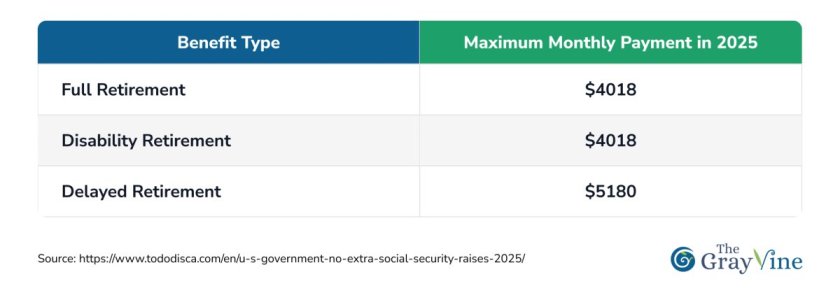Breaking: No additional Social Security increases in 2025—U.S. Government says
By
Aubrey Razon
- Replies 0
Retirement can feel like a tricky journey, especially with the future of Social Security benefits in question. These benefits are more than just figures; they are essential for everyday living.
That’s why the latest news from the U.S. Government has everyone buzzing: no extra raises for Social Security in 2025!
Before we dive into the implications of this announcement, let's unpack what the Cost-of-Living Adjustment (COLA) really means for you.
COLA is the annual adjustment made to Social Security payments to counteract the effects of inflation.
It's designed to preserve your purchasing power by ensuring that the money you receive keeps pace with the rising cost of goods and services.
The Social Security Administration calculates the COLA based on the Consumer Price Index for Urban Wage Earners and Clerical Workers (CPI-W), which tracks changes in the cost of living.
For 2025, the COLA has been set at 2.5%.
However, it's important to note that this is a one-time annual adjustment.
There won't be any additional increases throughout the year, regardless of fluctuations in the economy or inflation rates.
The 2.5% increase may seem modest, but it translates into tangible gains for Social Security recipients.
Here's a breakdown of the maximum monthly payments for various benefit categories in 2025:
These figures represent the upper limit of what beneficiaries can expect to receive, with the actual amount depending on individual earning records and the age at which you start claiming benefits.
The COLA ensures that these payments will be slightly higher than the previous year, providing some relief as you manage your expenses.
The decision to limit Social Security increases to a single annual adjustment is rooted in a long-term vision for the program's sustainability.
By applying the COLA once a year, the Social Security Administration aims to maintain a balance between offering adequate support to beneficiaries and preserving the financial health of the Social Security trust funds.
While the idea of additional raises might sound appealing, especially during times of high inflation, multiple adjustments could lead to instability and potentially jeopardize the program's future.
The annual COLA is a measured approach that offers a predictable increase, allowing beneficiaries to plan their finances with some degree of certainty.
The absence of extra raises in 2025 may be a cause for concern for some, but it's crucial to look at the broader context.
Social Security is just one piece of the retirement puzzle.
To navigate the year ahead with financial confidence, consider exploring other income streams, such as pensions, investments, or part-time work.
Additionally, budgeting wisely and cutting unnecessary expenses can help stretch your Social Security dollars further.
It's also worth noting that while the COLA is the standard method for adjusting benefits,
Congress has the power to enact legislation that could provide additional relief if economic conditions warrant it.
However, such measures are not the norm and should not be relied upon as a regular occurrence.

Have you started planning for the 2025 COLA increase? What strategies do you use to manage your finances in light of fixed Social Security raises? Share your experiences and tips in the comments below.
That’s why the latest news from the U.S. Government has everyone buzzing: no extra raises for Social Security in 2025!
Before we dive into the implications of this announcement, let's unpack what the Cost-of-Living Adjustment (COLA) really means for you.
COLA is the annual adjustment made to Social Security payments to counteract the effects of inflation.
It's designed to preserve your purchasing power by ensuring that the money you receive keeps pace with the rising cost of goods and services.
The Social Security Administration calculates the COLA based on the Consumer Price Index for Urban Wage Earners and Clerical Workers (CPI-W), which tracks changes in the cost of living.
For 2025, the COLA has been set at 2.5%.
However, it's important to note that this is a one-time annual adjustment.
There won't be any additional increases throughout the year, regardless of fluctuations in the economy or inflation rates.
The 2.5% increase may seem modest, but it translates into tangible gains for Social Security recipients.
Here's a breakdown of the maximum monthly payments for various benefit categories in 2025:
These figures represent the upper limit of what beneficiaries can expect to receive, with the actual amount depending on individual earning records and the age at which you start claiming benefits.
The COLA ensures that these payments will be slightly higher than the previous year, providing some relief as you manage your expenses.
The decision to limit Social Security increases to a single annual adjustment is rooted in a long-term vision for the program's sustainability.
By applying the COLA once a year, the Social Security Administration aims to maintain a balance between offering adequate support to beneficiaries and preserving the financial health of the Social Security trust funds.
While the idea of additional raises might sound appealing, especially during times of high inflation, multiple adjustments could lead to instability and potentially jeopardize the program's future.
The annual COLA is a measured approach that offers a predictable increase, allowing beneficiaries to plan their finances with some degree of certainty.
The absence of extra raises in 2025 may be a cause for concern for some, but it's crucial to look at the broader context.
Social Security is just one piece of the retirement puzzle.
To navigate the year ahead with financial confidence, consider exploring other income streams, such as pensions, investments, or part-time work.
Additionally, budgeting wisely and cutting unnecessary expenses can help stretch your Social Security dollars further.
It's also worth noting that while the COLA is the standard method for adjusting benefits,
Congress has the power to enact legislation that could provide additional relief if economic conditions warrant it.
However, such measures are not the norm and should not be relied upon as a regular occurrence.
Key Takeaways
- The U.S. Government has clarified that Social Security payments will see no additional increases in 2025 beyond the established Cost-of-Living Adjustment (COLA).
- The COLA for 2025 is set at 2.5%, affecting all Social Security payment categories including full retirement, disability retirement, and delayed retirement.
- The maximum monthly payments for each benefit type in 2025 have been calculated and announced to help beneficiaries cope with inflation.
- There is only one Social Security increase per year to maintain the sustainability of the program, and it's adjusted based on the Consumer Price Index (CPI).
Last edited:








